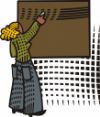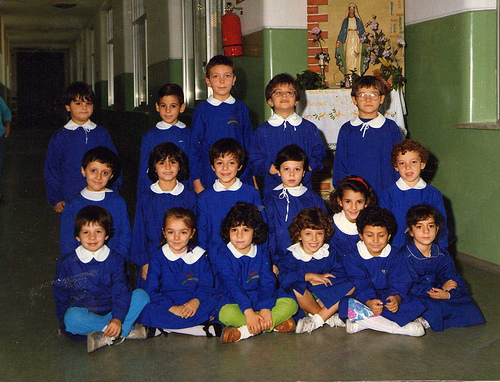|
ESL Forum:
Techniques and methods
in Language Teaching
Games, activities
and teaching ideas
Grammar and
Linguistics
Teaching material
Concerning
worksheets
Concerning
powerpoints
Concerning online
exercises
Make suggestions,
report errors
Ask for help
Message board
|
ESL forum >
Games, activities and teaching ideas > Schools in other countries
Schools in other countries
|
|

MarionG

|
|
Our school is a so called �experimental school � not necessarily representative of Israeli schools but nevertheless..
1. Do students pay school fees?
Regular schools are free, some schools -like ours- require a modest contribution per month enabling smaller classes and extra staff etc. Of course there is payment for schooltrips and sometimes art supplies.(in the highschool)
2. Do students wear uniforms?
Most schools in Israel have a school uniform (t-shirt only); it became mandatory a few years ago.Our school does not have a school uniform.
3. Do students buy lunch at school or bring lunch from home?
Most students bring lunch from home but there is a possibility to buy food at school, most schools in Israel don �t have this option.
4. When does compulsory education end?
I think officially it is at 16 but high school is until 17/18
5. When does the school year start and end?
primary school; September 1st to June 30th. High school Sept. 1st to June 20th
6. What time does the school day start and end?
Primary school Sun - Thu 8.00 to 1.30 or 2.14 and Friday 8.00 to 12.45 (note this is 6 days a week!) High school starts at 8 and is different for each student depending on classes they are taking (min. of 32 hours) Other schools in Israel may have different timetables.
7. How many students are there in each class (average)?
In our school classes can not have more than 28 kids but most subjects in our school are taught to half a class at the time, i.e. 14 (again, this is very different in most schools)
Hope this is useful, success
|
18 May 2011
|
|
|

Jayho

|
|
Australia has several states and the education system in each is different.
Generally:
1. Public schools no (although schools in higher soci-economic areas do ask parents to buy books whereas schools in disadvantaged areas use worksheets and free education department books). There is usually a small contribution fee for shared stationary and other items. Excursions are paid for by parents.
2. Primary school generally yes. Public Secondary school optional with most students opting not to wear a uniform. Private secondary school compulsory.
3. The majority of students bring their lunch, usually sandwiches. Canteens are staffed by volunteers and must provide healthy lunch options under new laws to combat childhood obesity.
4. In the Australian school system, students attend school for a total of 13 years. Up until recently they could leave at the end of junior secondary school (age 15/16) but now they are not allowed to leave before the end of senior secondary school (17/18) unless they receive approval to articulate to a training course, apprenticeship/traineeship or they have a bona-fide job to go to. This strategy was implemented to reduce unacceptably high youth unemployment in a job market with very low unemployment.
5. Late January/early February until December
6. School hours vary but are generally from 9.00 am to 3.30 pm each school day.
8. This varies but generally low twenties for lower primary classes and high twenties for all other classes.The biggest classes, in rare cases, might have just over 30.
Cheers
Jayho
|
18 May 2011
|
|
|

MarionG

|
Tkr-2011
I got curious, have to admit I had never heard of Kiribati before...
I googled.....WOW looks like paradise!!  |
18 May 2011
|
|
|

MJ_Misa

|
Hi.
In the Czech Republic:
1. Students don �t pay for public schools, but if they are attending a private school, there is, of
course, a fee.
2. No uniforms in my country.
3. Most of the children goes to canteen to have their lunch, some eat at home or bring a snack
from home.
4. The compulsory education starts at the age of 6 (sometimes 7) and ends at the age of 15
(16). Children have to go to school for 9 years, then they mostly go to colleges to get a
higher education and some of them continue to Uni.
5. The school year - from 1st September to 30th June, universities from October to July.
6. The school starts at 8 o �clock and ends between 11.40 and 15.20 depending on the grade.
7. The average is about 20 - 25 sts, in special classes where I also teach (sts with special
needs) the maximum is 14.
|
18 May 2011
|
|
|

inciska

|
1. Do students pay school fees? No, not in public schools.
2. Do students wear uniforms? Yes, and uniforms change according to schools.
3. Do students buy lunch at school or bring lunch from home? Some schools have got cafeterias and sts have lunch there. Some schools dont, so they bring their food with them.
4. When does compulsory education end? at the end of 8th grade
5. When does the school year start and end? September-June
6. What time does the school day start and end? It differs. Crowded schools have got morning students and afternoon students who share the same classes at different times. Small schools start usually at 8-9 in the morning and end at 2-3 afternoon.
7. How many students are there in each class (average)? 30 on average.
|
18 May 2011
|
|
|

ingela

|
|
Finland:
1. Do students pay school
fees? No, they don�t.
2. Do students wear uniforms? No, they don�t.
3. Do students buy lunch at school or bring lunch from home? They are offered a
free lunch at school.
4. When does compulsory education end? At the age of 15/16 (= at the end of the 9th grade).
5. When does the school year start and end? The school year begins in the
middle of August and ends at the end of May or in the beginning of June.
6. What time does the school day start and end? Primary school: the school
day starts between 8 and 10 a.m. and ends between 12 and 3 p.m.
7. How many students are there in each class (average)? 20-25. The classes are usually
divided into groups of 10-15 pupils in language teaching.
|
18 May 2011
|
|
|
|
|

yemen

|
|
Dear Sarah , In my country Algeria : - Pupils do not pay free . Education is free even at the university level. - Pupils are given books freely , but they buy supplies. - Poor pupils are given 3000 DA at the beginning of the year. -Pupils do not wear uniforms , but they wear pinafores. -Pupils who live far from the school stay for lunch and it �s free. -Cumpulsory education ends at the end of the 5 th grade. -The school year starts in September and ends in May. -The school day start at 8 o �clock and ends at 4 o �clock. -The number of pupils is 30 in average. |
18 May 2011
|
|
|
|
|

bibikos

|
|
In Greek state schools you don �t have to pay fees whereas in private schools you have to pay fees. Students don �t have to wear uniforms. However, there are some private school that ask students to wear special track suits for gymnastics. The school year starts on 15th September and ends on 15th June. The school day starts at 8:00 - 8:30 until 2:00 for primary schools while secondary and high schools stay up to 3:00. Children bring their food from home apart from some private schools that provide lunch (if the parents want to pay extra for it). Classes can be overcrowded in private schools with numbers up to 30 students. State school classes have up to 20 students. Finally, education is compulsory until the end of secondary school.
|
18 May 2011
|
|
< Previous
1
2
3
4
Next >
|













 smock
smock



